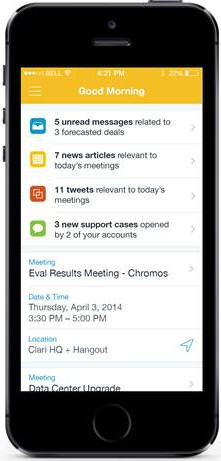Roger Lee
Editor’s note: Roger Lee is a general partner with Battery Ventures.
Seven years ago when the iPhone was first introduced, smartphones were a novelty. Now they’re the default method of computing for most people. As of late last year, Americans spent 34 hours a month on their mobile devices, compared with just 27 hours accessing the web via a computer, according to Nielsen.
This mobile-first mindset has also deeply permeated the enterprise. Some 95 percent of knowledge workers own smartphones, and they reach for them first to do all kinds of tasks – from email and document sharing/management to meeting planning and videoconferencing.
Smartphones and tablets are also rapidly entering business sectors such as construction, shipping, manufacturing, healthcare, real estate, education, law enforcement, fleet management and others. Most people have noticed field workers using mobile devices equipped with industry-specific apps (everyone from rental-car agents to home contractors) to complete tasks on the go.
As Salesforce.com CEO Marc Benioff recently said at a technology conference: “Today I run my business from my phone; I could never have imagined that a few years ago.”
So for enterprise software entrepreneurs, this platform shift has massive ramifications on product roadmap, product design, hiring, go-to-market strategy and pricing. In other words, it impacts everything.
If you’re building an enterprise-software company, mobile must be core to your product strategy; it can’t be an afterthought or add-on. And you must build an elegant, easy-to-use mobile app, because employees and consumers far prefer mobile apps to mobile websites. U.S. smartphone users spend 86 percent of their time on mobile apps, vs. 14 percent of their time using mobile browsers.

One example of an enterprise startup getting it right with mobile is Clari, a CRM software company. At right, a screen shot of the clean, great-looking Clari Daily Brief – perfect for a sales rep on the go whose smartphone is his or her primary computing device.
There’s also PagerDuty, a company that alerts IT professionals to potential problems via SMS and email. Also in the market is CoTap, a mobile-first messaging system for workplace teams—sort of like WhatsApp for business.
These companies and others illustrate a few key precepts that entrepreneurs should keep in mind when trying to build a mobile-first product and mobile-centric company culture.
Pick one platform to get product/market fit. iOS and Android are very different environments and, as a resource-constrained entrepreneur, you need to pick one. Be conscious of the types of devices your end customer will be using and think through the pros and cons of each platform (e.g. Android is easier to release/iterate in the early days as you are searching for product/market fit, while iOS can be easier to monetize). Once you have made your platform decision …
Hire dedicated developers for that platform. You will need a dedicated team of three to four engineers/designers for either iOS or Android. These folks are tough to find, but you don’t have a choice. To build an A+ mobile app, you need a dedicated team that is solely focused on building in iOS or Android.
Design, design, design. You only have a few minutes to convince users your mobile app is valuable. If they have to spend 2-3 minutes struggling to understand how to use it, you’ve likely lost them for good. A great mobile app is intuitive from the first minute a user taps on it. But designing something so elegant is extremely difficult. You need great designers and lots of them. Make sure an experienced designer is one of your first few hires, or ideally part of the founding team. Then, aim to hire one designer for every three to five engineers going forward.
Think through workflow and how it impacts the user experience. This is stating the obvious, but the way people use smartphones and tablets is vastly different from the way they manipulate keyboards and mice. Instead of relying on clicks and text entry – the standard for enterprise desktop apps for decades – you’ll need to design mobile workflows based on taps and swipes. Depending on your mindset, this can be either scary or liberating. Embrace this design constraint and you will be surprised at what is possible.
Don’t overbuild. Another key to success with mobile apps is to keep it simple. Don’t build in too much functionality, and make sure the user can get real value within three to four swipes/taps. Most incumbent software vendors have not figured this out, as they take their year 2000-era software playbook and cram in too much functionality, yielding a bloated and difficult-to-use product. Don’t fall into that trap. Keep it simple.
Decide if your app plays a standalone or support role. Just because people vastly prefer to use smartphones over their PCs doesn’t mean there aren’t some work tasks that still require a computer. Startups like Accompani are getting this balance right. The company, which makes relationship-management software, can fulfill on-the-go use cases over customers’ mobile devices but accomplish batch-processing type tasks — clearing out your inbox, prepping for the next day full of meetings — on a PC or tablet.
After all, programming, graphic design, writing, creating presentations and other jobs are still mostly done using keyboards and large screens. Figure out if your mobile enterprise app is for a task that never, ever needs a computer, or conversely, if it needs to work in conjunction with a desktop application. Everything from how you design the mobile app interface to whether you need mobile-desktop sync will depend on this critical distinction.
Even if you didn’t start your company as a mobile-first business, there is still time to make this massive pivot. Facebook did it – moving from a consumer, desktop-based website to a mobile-first app – and changed its entire revenue stream in the process. If a huge company like Facebook can do a mobile about-face, your smaller enterprise software startup can, too.
You just have to throw out all your old ideas about how users interact with your software and put all your energy into designing a streamlined, elegant, efficient mobile app. It won’t be easy, but it has to be done. Otherwise, your enterprise software company may slowly fade away as a relic of the bygone desktop era.































Comment